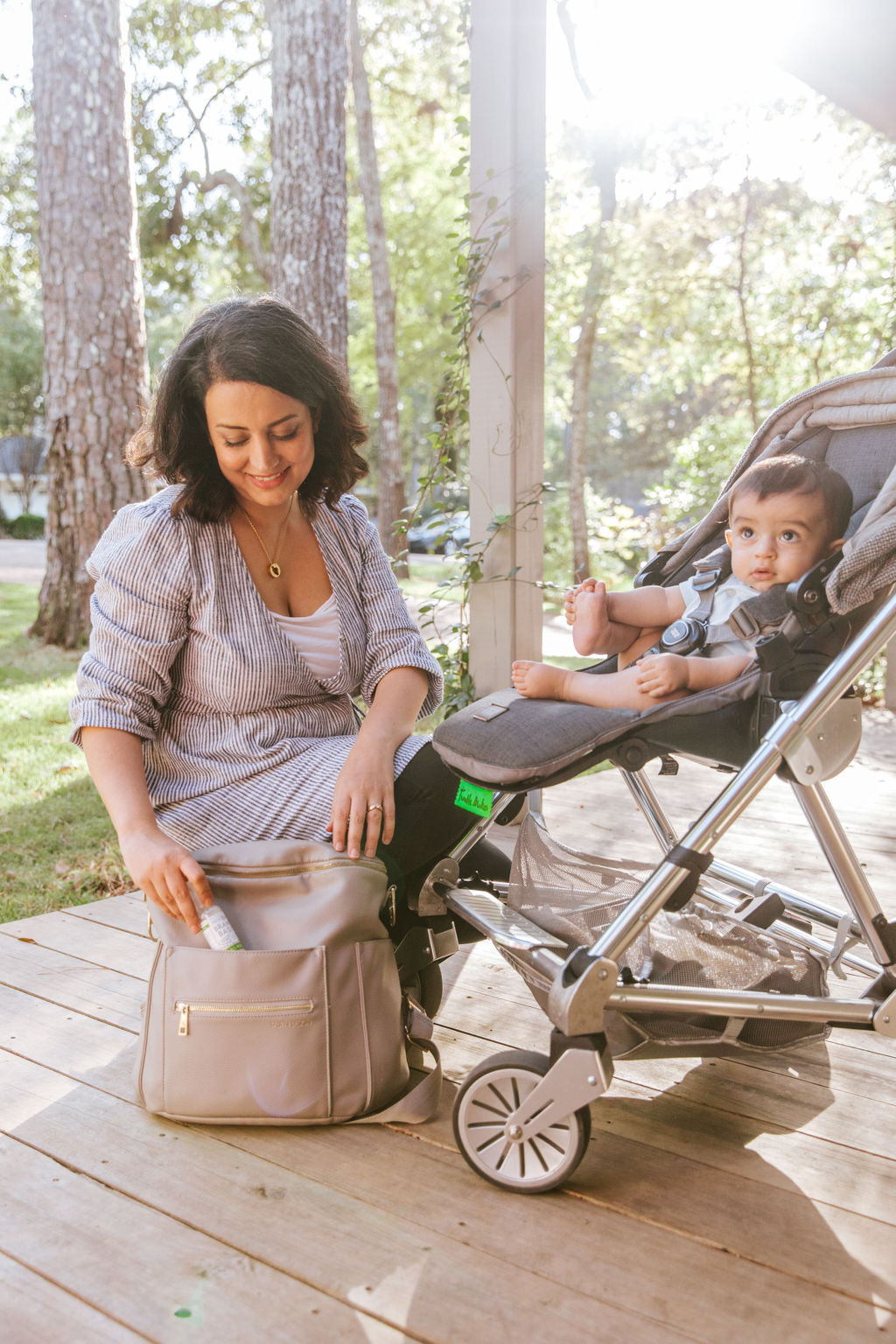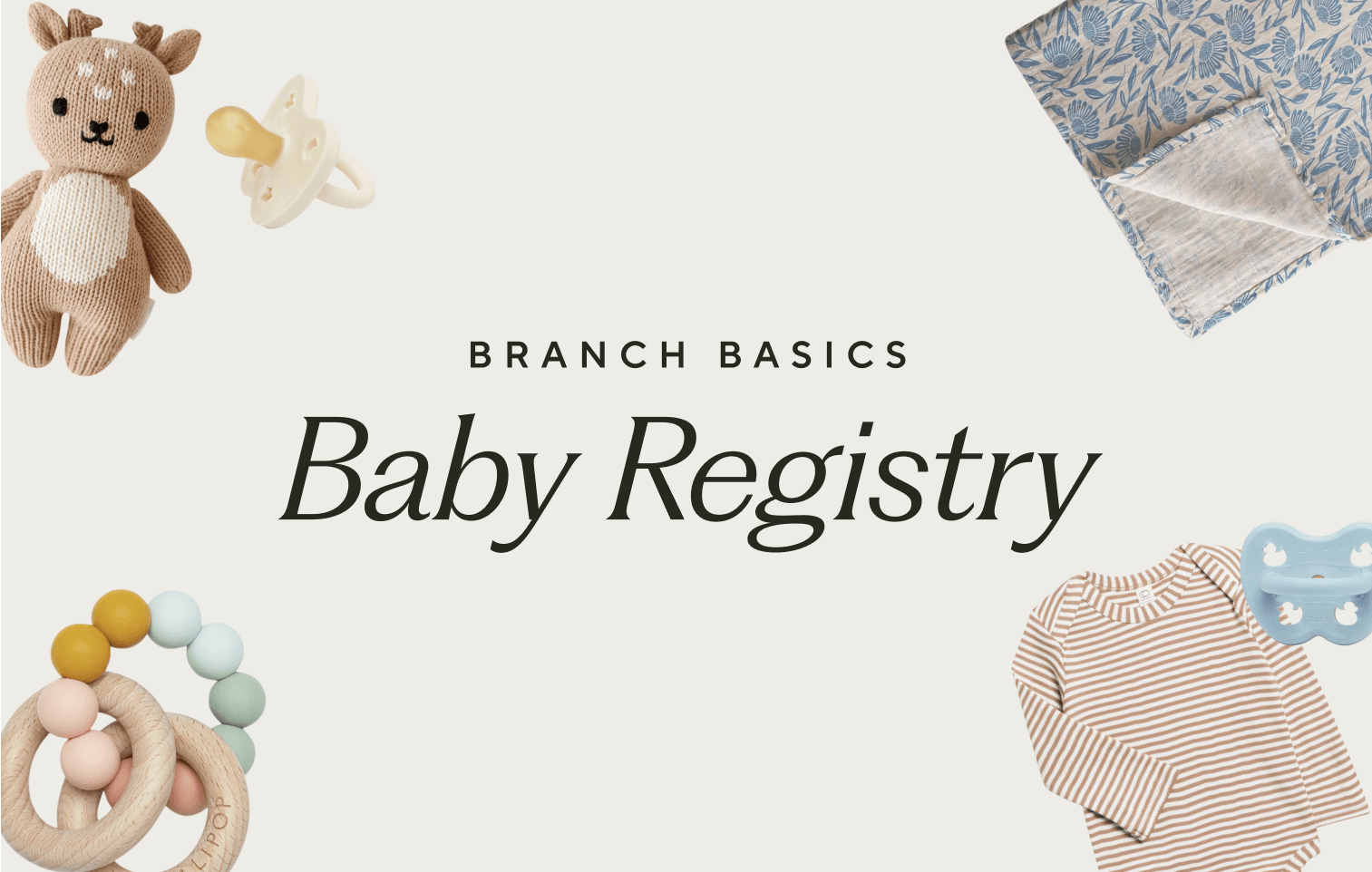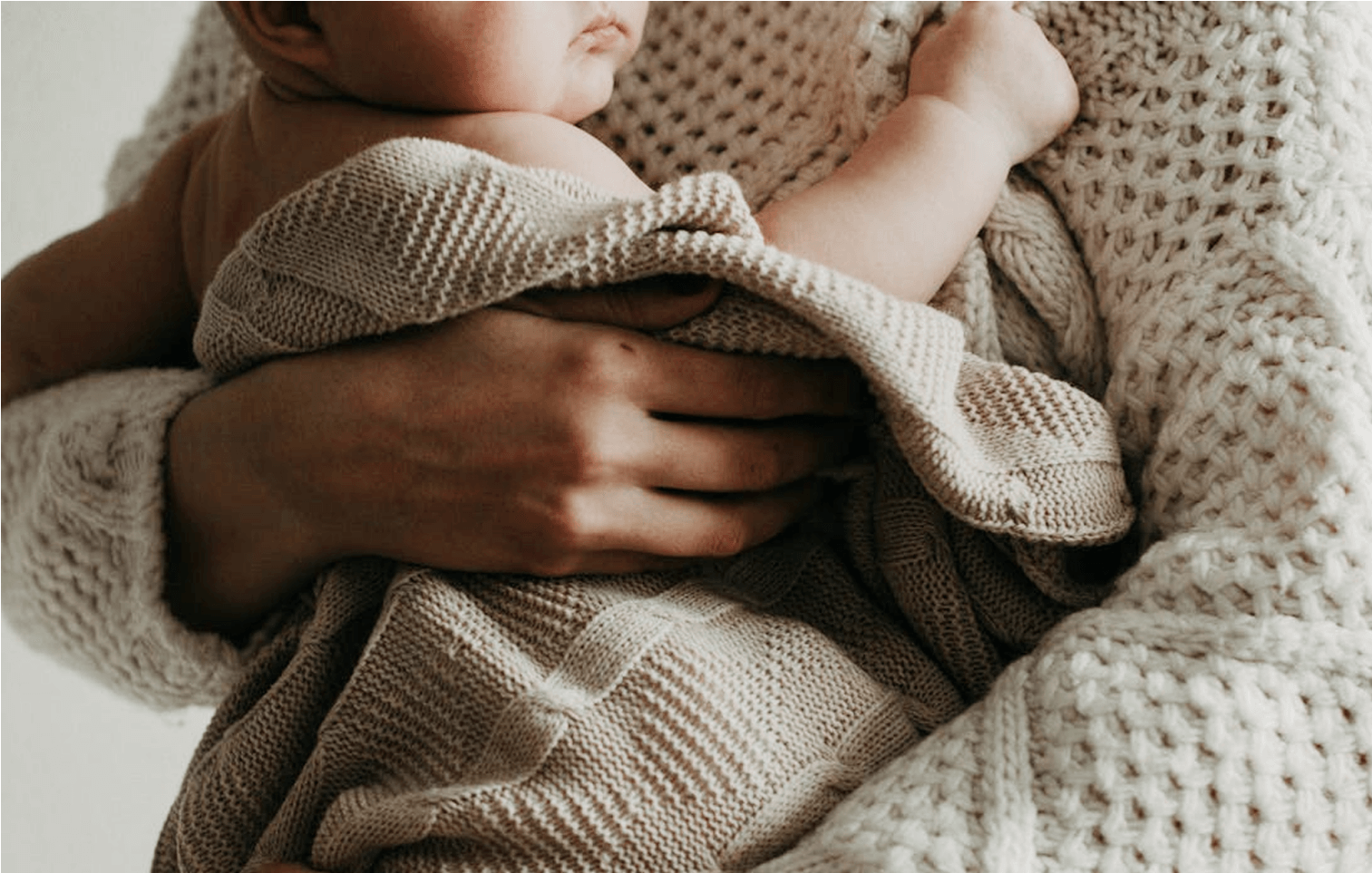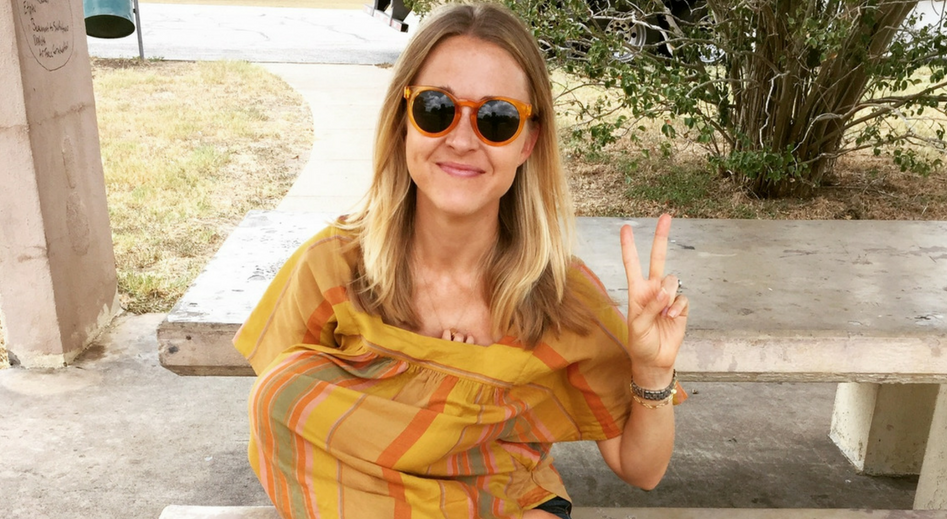Our Favorite Baby- Friendly Cleaning Products

Having a baby changes everything—even how we clean our homes, wash our laundry, and do dishes.
So, if you are suspicious of the disinfecting wipes, ultra-scented laundry detergents, and colorful dishwashing pods you’ve always used, know your parental instincts are right on!
The sad truth is most synthetic chemical-based cleaners, laundry detergents, disinfectants, and dish soaps are not safe for pregnant mothers, babies, or children.
And, in our opinion, these do not belong in a healthy, baby-safe home.
So, what are the best baby-friendly cleaning products?
In this article, we’ll explore our favorite options for baby-friendly dish soaps, laundry detergent, and all-purpose cleaners, plus which ingredients to avoid, how to safely disinfect baby toys, the best safe and natural baby wipes, and much more.
Ingredients to Avoid in Cleaning Products
The number of harmful synthetic chemicals allowed in cleaning products marketed to families is unacceptable and frankly quite shocking.
For example, did you know, per the Centers for Disease Control, that exposure (even passive exposure) to common household bleach and other disinfectants have been linked to an increased rate of miscarriage, preterm birth, and developmental harm?
Yet they do not know at what rate of exposure it becomes problematic for pregnant mothers and their babies!
Bleach has also been linked to increases in the risk of asthma, immune problems, respiratory issues, and microbiome disruption.
Yet, these poisonous disinfectant products are marketed as a must-have to new parents to “protect” their babies from getting sick.
Therefore, it is essential that parents and caregivers become aware of the toxic ingredients that may be lurking in conventional and even “organic”, “green”, “fragrance-free”, “natural”, and “sustainable” products.
Ingredients to avoid in cleaning and laundry products for babies:
- Alcohol: Can be harmful to the liver and other organs if accidentally ingested or applied topically.
- Ammonia: Found in glass cleaners, all-purpose cleaners, and more, ammonia is toxic to humans if ingested or inhaled. It can also create noxious gasses if mixed with other chemicals.
- Chlorine: Chlorine and chlorine bleach should be avoided due to its caustic nature and reproductive, developmental, and other harms. Learn more in: Is Sodium Hypochlorite (Bleach) Toxic?
- Dyes: Synthetic dyes are dangerous for several reasons. #1: Their bright colors make cleaning products more enticing to children, #2: They contain a cocktail of potentially harmful chemicals, including heavy metals and formaldehyde-releasing chemicals. Dyes are also absorbed by the skin, which (just like dyes in food) can cause behavioral problems in some children.
- Ethoxylates: A type of chemical-based surfactant detergent-like chemical that’s associated with reproductive and developmental effects in animal studies.
- Formaldehyde: Formaldehyde is used as a preservative in cleaning products, and many cleaning products contain formaldehyde-releasing chemicals. You typically won’t find the word “formaldehyde” on the label. Instead, look for:
- DMDM hydantoin
- Methylene glycol
- Quaternium 15
- 3 dioxane
- Fragrance: Synthetic fragrance is considered a top allergen and can contain dozens of endocrine-disrupting chemicals and carcinogens. Learn more in: Fragrance is the New Secondhand Smoke: Eliminate Synthetic Fragrance to Improve Your Health.
- Methylisothiazolinone & Methylchloroisothiazolinone: Synthetic preservatives linked to neurotoxicity, allergies and immunotoxicity.
- Parabens: Paraben exposure in utero has been linked to childhood weight problems, changes in the reproductive health and proper genital development of boys, and impaired testosterone function in boys.
- Petroleum solvents: These come from petroleum products and typically are labeled with the word “poly” or “P.” Petroleum-based solvents have a long list of potential toxicity concerns, and many are endocrine disruptors and possible carcinogens.
- Phosphates: Phosphate residues have been known to cause nausea, diarrhea, and skin irritation, which you do not want for your baby.
- Phthalates: These endocrine-disrupting chemicals are also toxic to children’s brain development, and may increase the risk of behavioral and cognitive disorders (ADHD and autistic behaviors, reduced mental, psychomotor, and IQ development, and emotional problems). Despite more studies being needed to better understand the role of these substances, plenty of evidence suggests the impact of phthalates on the neuroendocrine system development and function. They are common in fragranced products. Learn more in: All About Phthalates and Why You Should Avoid Them.
- SLS (Sodium Lauryl Sulfate), SLES (Sodium Laureth Sulfate), and other Sulfates: These synthetic surfactants and emulsifiers can irritate delicate skin and are linked to organ system toxicity and are eye, lung, and skin irritants. SLES can also contain dioxins, a known carcinogen the EPA says causes an “unreasonable risk of injury to health.”
- Quats (quaternary ammonium compounds): Quats, also known as QACs, are ammonia-based disinfectants used in cleaning products, dishwashing soap, hand soap, laundry products, wood products, water purification (algaecides, for example), textile production, and in other household products like Lysol 1 . They are EPA-registered pesticides, have an “F” rating from EWG, and may cause
- Birth defects
- Decreased mitochondrial function
- Developmental toxicity
- Disruption of cholesterol
- Inflammation
- Neurodevelopmental issues
- Proliferation of drug-resistant bacteria
- Respiratory issues
- Reproductive toxicity
- Toxicity to aquatic life
- Triclosan: This antibacterial ingredient has been banned in many over-the-counter products due to its toxic effects on humans (microbiome, thyroid function, and hormonal function) and the environment. Unfortunately, it may still be found in disinfecting wipes and other cleaning products, so always check labels.
This is not a complete list of chemicals to avoid in cleaning products if you have babies or young children. However, it does cover some of the worst offenders.
Many people do not realize cleaning and laundry product companies are not required to list all their ingredients on labels!
However, thanks to technology, you can use tools like the Environmental Working Group’s (EWG) Skin Deep database to vet cleaning products and product ingredients.
You can also look for these badges and certifications to ensure a baby-safe, natural and pure product:
- Cruelty-free
- Made Safe Certified
- Fragrance-free
- Organic
- Non-GMO
Learn more in: 3 Tools You Need to Become Your Own Product Advocate.
Baby-Friendly Dish Soaps
Dish soaps and detergents are often one of the last things we consider when switching to baby-safe cleaning products.
Yet, they contain some of the most toxic ingredients—especially dishwashing detergent, which contains highly caustic chemicals capable of killing a baby or child if ingested.
Dish detergent is the #1 cause of childhood poisoning in this country (yikes!).
Plus, dish soap is often within reach of babies as we wear them or balance them on our hips while doing dishes, preparing snacks, etc.
Bottom line: human-safe dishwashing matters a lot. Especially when you have babies around.
Here are some baby-safe dish soaps and dishwasher detergents you can feel good about.
Branch Basics Foaming Wash, All-Purpose, Bathroom, or Concentrate
Did you know most Branch Basics products can be used for hand-washing dishes, including baby bottles, sippy cups, etc.? Talk about convenience!
Here’s how to use them:
- Use All-Purpose for lightly soiled dishes. Just spray it on, scrub, and rinse.
- For bigger jobs, Foaming Wash or Bathroom dilution work best. Squirt directly into your sink with hot water, submerge dishes and wash. Or spray directly onto dishes, scrub, and rinse with hot water.
- You can also use 1 teaspoon of Concentrate in the sink for excellent results.
- And use Oxygen Boost for scouring, getting stubborn stains off blenders or coffee pots, and cleaning burnt-on food.
Branch Basics is EWG-Verified, Made Safe Certified, human-safe, ultra-gentle, all-natural, and safe to use around babies.
We’re so confident in these gentle, human-safe formulas we even have our toddlers help us wash the dishes using these products, which are third party certified to not be eye or skin irritants. Once you try them, you’ll love them.
Liquid Fragrance-Free Castile Soap + Water
Liquid castile soap is a favorite among the toxin-conscious and DIYers for cleaning, personal care, and much more.
Here’s how to use it to make a baby-safe, DIY liquid dish soap:
- Mix 1 part fragrance-free liquid castile soap with 4 parts water in a jar or dish soap bottle.
- Shake and use like regular dish soap for hand washing dishes.
When selecting a castile soap to use around babies, we recommend 100% fragrance-free castile soap with no essential oils. Also note, that natural soaps are eye irritants and respiratory irritants when sprayed.
Branch Basics Dishwashing Tablets
Branch Basics Dishwasher Tablets are ultra-concentrated, PVA free, plastic-free, contain no synthetic caustic chemicals, and all ingredients are rated 1-2 on EWG.
As always, our number one priority is human-safe (and baby-safe) ingredients.
Our Dishwasher Tablets are:
- Plant and mineral based
- Non-GMO
- Dye free
- Ethoxylate free (no 1,4-dioxane)
- Phosphate free
- Completely fragrance-free - with no VOC emissions when the dishwasher is running OR when opening the hot dishwasher
- Not irritating - cause no irritation to the eyes, skin or lungs when used as directed
To use, add one tablet to your dish detergent cup, turn on the dishwasher, and that’s it.
To learn more, check out: Our New & Improved Dishwasher Tablets.
Baby-Friendly Laundry Detergents
You’ve probably heard that babies benefit from gentler laundry detergents. But don’t be fooled!
Many laundry products marketed to babies as “safe, gentle, and fragrance-free” still contain many of the same dangerous chemicals as their brand-cousins.
For example, fragrance-free laundry products often have fragrance-masking chemicals added, making them even worse for developing babies.
Instead, we recommend the following human-safe and all-natural laundry detergents.
Branch Basics Laundry + Oxygen Boost + Wool Dryer Balls
Branch Basics Laundry and Oxygen Boost are an ideal combination for keeping baby clothes clean, snuggly-soft, and stain-free.
Sustainably made Wool Dryer Balls replace the need for fabric softener and dryer sheets while saving you time and money.
Branch Basics Laundry is made from our signature EWG-Verified, Made-Safe, All-Natural Concentrate + water and can clean any type of clothing thoroughly and naturally without any synthetic chemicals, detergents, preservatives, dyes, or fragrances.
Oxygen Boost is a mineral-based natural whitener, deodorizer, laundry booster, stain remover, and bleach alternative that baby parents swear by (good-bye blow-out, spit-up, and baby food stains!).
For easier laundry days, try out our new laundry detergent! Just one scoop will effectively lift stains and remove odors.
To use Branch Basics Laundry in the Washing Machine:
- Dilute Concentrate with water per bottle instructions.
- Add 3/4 of a capful to your washing machine.
- If desired, add a scoop of Oxygen Boost.
- Wash your clothes.
- Add Wool Dryer Balls to the dryer to naturally soften clothes, and reduce drying time, static, wrinkles, and lint, and leave your baby’s clothes (and the whole family’s clothes) smelling extra fresh.
For handwashing a few items, generally one teaspoon of Laundry dilution in a basin of water is plenty.
For soaking stained baby clothing, add about half a scoop of Oxygen Boost to a basin of water and soak for 30 minutes to several hours.
Soap Nuts
Soap nuts are a safe, natural, and very economical choice for babies because their natural saponins clean clothes and act as a fabric softener.
They’re also biodegradable, last for several washes, and can be used to create different household cleaning products.
To use, place 4-5 soap nuts in a cotton bag and launder your baby’s or family’s clothing as usual.
Soap nuts are available in brick-and-mortar and online natural food stores and co-ops, health food stores, and natural living stores.
Baking Soda & Vinegar
If you’re looking for an inexpensive and natural DIY laundry detergent that’s safe for babies, look no further than your kitchen pantry.
Baking soda and plain white vinegar will clean, soften, and deodorize your baby’s clothing while doing double-duty to clean, deodorize, and descale your washing machine.
Here’s how to use baking soda + vinegar to wash baby clothes (or grown-up clothes):
- Add half a cup of distilled white vinegar to your washing machine.
- Add 1 cup baking soda.
- Run the desired laundry cycle, and that’s it.
For handwashing, reduce the amount of each product you use.
For example, a small wash basin or bowl would require 1-2 Tablespoons of baking soda and 3-4 tablespoons of vinegar.
*Note: Vinegar is an all-natural product that contains acetic acid, which, when aerosolized, can irritate the lungs. Using vinegar in the laundry does not pose that problem as the vinegar is not used as a spray.
Discover more safe and natural laundry detergent alternatives in: 10 Laundry Detergent Alternatives that Actually Work
Baby Friendly All Purpose Cleaners
A safe, pure, and natural all-purpose cleaner is a must when cleaning up after a baby, wiping down toys, etc.
These options contain no synthetic chemicals or fragrance and work like a multi-purpose charm.
Branch Basics All-Purpose
Branch Basics All-Purpose is our go-to cleaner for use around our babies, toddlers, and children of all ages.
It’s economical and super simple to make by combining Branch Basics Concentrate + water, and it’s excellent for:
- Removing germs
- Cleaning baby toys
- Wiping down surfaces
- Removing stains on clothing
- Cleaning the floor
- Washing produce
- Cleaning baby bottles
- Hand-washing dishes
- Wiping down high chairs
- Cleaning car seats
- And much more
Note: Branch Basics All-Purpose is a human-safe, all-natural cleaner designed to remove germs. It is not a disinfectant…and that’s on purpose.
We’ll share more about human- and baby-safe disinfecting options for families coming up.
Learn more in: Is Branch Basics a Sanitizer or Disinfectant?
Vinegar & Water
Natural mamas love vinegar for a reason; its natural acetic acid acts as a gentle yet effective non-toxic cleaner for removing dirt, grime, and eliminating certain germs such as:
- E. Coli
- Salmonella
- Listeria monocytogenes
How to Make a DIY All-Purpose Cleaner Using Vinegar (and use it safely around babies):
- Mix equal parts distilled white vinegar with water in a squeeze bottle
- Squeeze or pour onto surfaces to clean and kill germs
Note: Vinegar has acetic acid, a lung irritant when sprayed. Therefore, we recommend pouring or squeezing it vs. spraying it around your baby’s developing lungs.
Do not spray vinegar in the presence of babies, children, older people, and those with lung or chronic health conditions.
Learn more in: 12 Ways To Use Vinegar In Your Home.
See: 5 Best Natural All-Purpose Cleaners for more human-safe all-purpose cleaning options.
Toss the Toxins With Branch Basics
Parenting can be overwhelming, especially when taking extra steps to avoid the toxic cleaning products most people use daily.
We see you, we get you, and we encourage you—as working moms of many littles ourselves—to carry on with gusto!
Once you know what you’re doing, as outlined in this article, choosing baby-friendly cleaning products is very simple and will keep your whole family much healthier in the short and long term.
This is one of the main reasons we developed the Branch Basics cleaning system: to simplify human-safe, natural cleaning for busy families.
Branch Basics Premium Starter Kit comes with a full-size Concentrate plus reusable glass or plastic bottles with printed measurement lines to make:
- All-Purpose
- For everyday cleaning including countertops, dishes, produce, floors, as a stain-remover and stains.
- Bathroom
- Tackles tiles, toilets, grout, sinks, and showers.
- Streak-Free
- Leaves mirrors, windows, and glass sparkling.
- Foaming Wash
- For handwashing, dishes, pets, as a baby wash, an eye make-up remover, and bubble bath.
- Laundry
-
Works for standard and HE washing machines.
It also comes with our best-selling Oxygen Boost for laundry, stain removal, bathroom cleaning, grout cleaning, dishwashing, and more.
Explore our Starter Kits and get yours here.
For more tips and advice on creating a human-safe, natural and healthy home for your baby, check out the following articles:
- How to Vet Products for Your Baby Registry
- Our Non-Toxic Baby Registry
- Our Favorite Non-Toxic Baby Toys for Development and Growth
Have Questions? We’ve Got Answers
We get so many questions about the best baby-friendly cleaning products and how to use them!
Here are a few answers to FAQs to help you on your natural parenting journey.
How do I safely disinfect baby toys?
Every parent should know how to safely disinfect baby toys without using synthetic chemicals. Yet no one teaches us how!
Here are a few methods you can use to safely sanitize and disinfect your baby’s toys, pacifiers, bottles, etc. without exposing your family to synthetic chemical-based disinfectants:
There are plenty of ways to clean and sanitize baby toys and other items without harmful chemicals.
- Always wash item first with soap and water to remove germs.
- Use boiling water to clean and sanitize heat-proof pacifiers, bottles, breast pump accessories, and toys that can stand up to the heat and moisture.
- Disinfect using vinegar and peroxide used separately and stored in separate bottles. This achieves a disinfectant effect that won’t harm you or your baby.
- Simply clean the toy using soap and water and dry.
- Spray with either the vinegar or the peroxide.
- Allow to dwell for about 5 minutes.
- Wipe or rinse off.
- Repeat with the other product. Rinse.
- Again, these must be stored in separate bottles and used separately. Otherwise they can create a harmful gas.
- Use the dishwasher + ultra-gentle dish detergent like Branch Basics Dishwasher Tablets, to naturally steam clean heat-resistant items.
- Steam clean: A hand-held steam cleaner is a fast and convenient way to sanitize surfaces and baby toys. However, since these pose a very real risk of severe burns, never use it while holding/wearing your baby, keep it out of reach of your other children (these are very tempting to children), and keep out of their reach while they cool down.
Get more tips in: How to Clean Your Baby’s Toys and Bottles Naturally.
What do you clean floors with when you have a baby?
Floor cleaning becomes almost like an Olympic sport when you have crawling babies around.
This makes it even more important to clean your floors with baby-safe and natural cleaners that do not leave behind any residue that could end up in the baby’s mouth, on her skin, in his eyes, or lungs.
It’s also why we recommend a no-shoes indoors policy—during babyhood and any time.
There are many options for baby-safe natural floor cleaning including:
- Branch Basics All-Purpose or a custom dilution, depending on your floors
- Branch Basics Concentrate diluted in a bucket for mopping or for use in a carpet cleaner
- HEPA vacuuming for hard or carpeting flooring, surfaces, etc.
- Microfiber mops
- Steam mops (use with extreme caution around babies and young children)
- Oxygen Boost for cleaning tile grout
- Fragrance-free liquid castile soap + water—dilute per product instructions specific to your floor type
- Lemon juice + water—diluted for your specific floor type
What about vinegar for floors?
Since vinegar contains acetic acid, which is a lung irritant, we do not recommend using it on floors if your baby is at home.
However, you could use it if the baby is out of the house and there is enough time for the vinegar smell to dissipate with good ventilation.
Get more tips and specifics on dilutions and floor types in: Branch Basics Ultimate Guide to Synthetic Chemiacl-Free Floor Cleaning.
What kind of wipes are safe to use on baby toys?
Wipes can be a convenient way to clean baby toys quickly.
However, it’s important to understand that any disinfecting wipe—natural or otherwise—requires dwell time, usually at least 5-15 minutes, to kill bacteria effectively.
So, you can’t just wipe the toy and have all the germs magically disappear.
Plus, wipes made with toxic disinfectants, like quats or triclosan, leave behind poison that should not be near a baby’s mouth, hands, eyes, etc.
Instead, we’d recommend removing germs using one of the natural all-purpose cleaners listed above and then following up with a safe and natural disinfecting procedure.
Branch Basics Mini All-Purpose is an excellent on-the-go cleaning option.
Yes, this may require a few more minutes, but it’s time well-spent to protect your child/children from synthetic chemicals and/or germy toys that could make them sick.
Categories

Marilee Nelson
Marilee Nelson is an Environmental Toxins expert who has spent nearly 30 years advocating for the chemically-sensitive and chronically-ill. She is a Board Certified Nutritionist, Certified Bau-Biologist and Bau-Biology Inspector and specializes in Food As Medicine. She has helped thousands of families and individuals identify, heal and recover from toxic exposures and is on a mission to revolutionize the way American families view their health.








